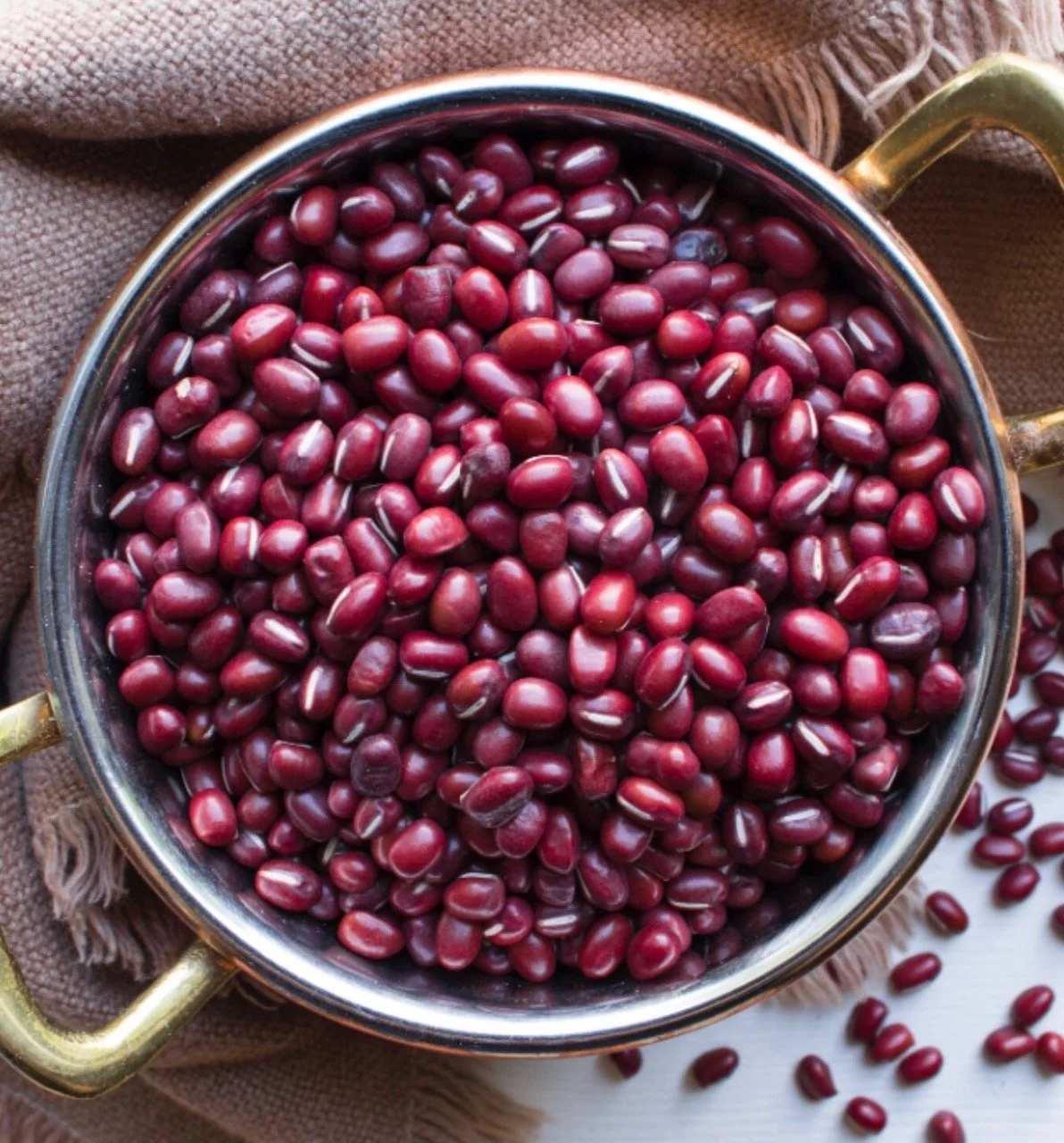Aduki Bean Squash Stew
aduki beans - mild, sweet, nutty, and. earthy taste - small red beans are cultivated in East Asia
I learned about aduki beans in the 90’s when I studied and followed a macrobiotic diet. I was on a guided food plan and lifestyle to clean my body from toxins that were irritating my skin - a.k.a. eczema (my story is on my site).
Aduki beans are sweet, small, red beans, also known as Himalayan lentils. They are super powerful because they are loaded with nutrition: protein, fiber, zinc, magnesium, iron, potassium, folate, and supports kidney health. Aduki beans build energy - yang power (that’s my yogi lingo talking). They leave your gut with a warming feeling during and after you eat them, which makes these beans perfect for the cold Fall and Winter months.
The high fiber in aduki beans cleanses the small intestines, kidneys and bladder from toxins. Adzuki beans are less uncomfortable to digest as other beans. I'’s still recommended to soak (30 minutes or over night) and rinse after soaking. Aduki beans are unique as they don’t have the saponins that the other beans have which causes the gas and gut discomfort. The saponins are bitter tasting plant chemicals and foam up in water. They can and should be skimmed off the top when cooking. Removing saponines form your beans and legumes will make your dish tastier and more digestible.
There are many people who do not digest legumes or beans well as they can experience problems with flatulence and allergies. I hear that a lot - so they don’t eat beans and legumes at all. In many of these cases the problem may be in improper preperation of the beans or legumes prior to cooking them. The issues can also be poor food combining.
Traditional Chinese Medicine TCM and Ayurveda - principals to stay healthy and balanced: eat at regular times, eat protein at every meal, water and teas before and after meals, avoid fried foods, eat according to the seasons, detox at least once a year.
Traditional Chinese Medicine uses legumes as healing foods because of their five element color. For example: red legumes such as aduki bean, red lentils, kidney bean influence the fire element: heart, small intestines. Yellow legumes such as garbanzo (chickpeas) bean, yellow pea, and soybean influence the earth element: spleen, pancreas, and stomach. White legumes such as lima bean, navy bean, and great northern bean influence the metal element: lungs, large intestines. Dark, black, and brown legumes such as black bean, black soybean, and brown lentil influence the water element: kidneys, and bladder. Green legumes such as mung bean, green pea, and fresh green bean influence the wood element: liver, and gall bladder. This might all sound Chinese to you (no pun intended), but as we very well know by now - food is medicine!
Source: Healing With Whole Foods - Oriental Traditions and Modern Nutrition - Paul Pitchford
mise en place
Recipe - serves 4
1 cup aduki beans, soaked and rinsed
1 3-inch piece of kombu sea vegetable
4 slices fresh ginger root
4 1/2 cups water
1-2 cups butternut squash, chopped in bite size pieces
1 tbsp. shoyu - soy sauce
1/2. tsp salt
chopped parsley for dish and garnish
Instructions
combine aduki beans, kombu, ginger root, and water in a 2 quart pot
bring to boil and cook for 30 minutes - or until squash is soft - remove ginger slices
add shoyu or soy sauce, salt, and parsley and gently toss with squash and aduki beans
garnish each serving with additional parsley
Genia’s Spoon Me Tips
Ayurveda (science of life/food/healing) recommends eating beans, dahl, and lentils that are well-cooked for easy digestion. Although, aduki beans are way up there in nutrition. Adding spices such as hing (asafetida), cumin, black pepper, and ginger helps to process digestion, reducing the side effects that we associate beans with, such as gas and bloating.
Soak your beans or legumes for at least 30 minutes or overnight and strain in the morning - than rinsing them very well before cooking. It’s all in the details! This method will make them more gut happy. Give it a try! Beans and legumes are so nutritious for you especially when combined with rice, spices, and good quality fat (ghee or extra virgin olive oil). Together this dish makes a complete protein. Btw, the fat added will make the dish moisturizing for the body if you tend to be on the dry side.
Kombu is a seaweed - also known as kelp. They (many different seaweeds) are found in the sea forest. They improve digestion, reduce gas - and that’s why I always add them to my grains, beans and legumes. Seaweed has so many health benefits (loaded with iodine which activates the thyroid hormone and regulates metabolism). They even make cleaning your pots and pans when cooking with seaweed easier because of their seaweed texture. You can find seaweed in health food stores and Whole Foods.
Much love and peace,
Genia



